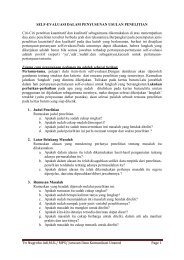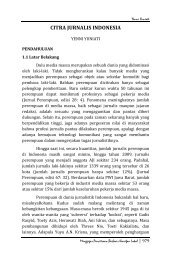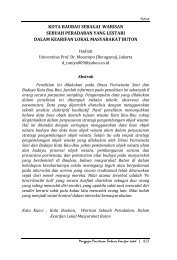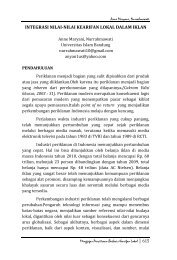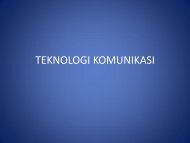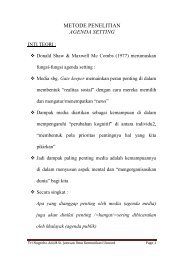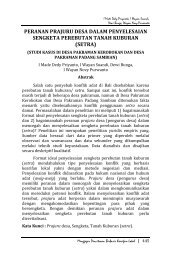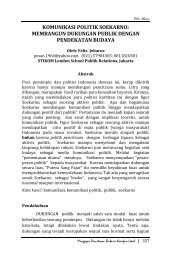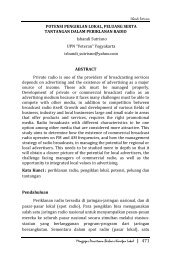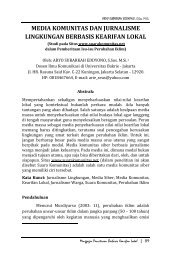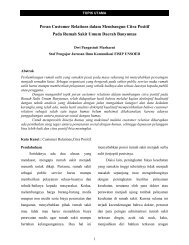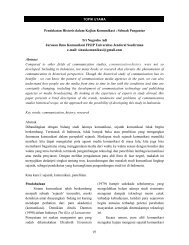New Vocabularies in Film Semiotics
New Vocabularies in Film Semiotics
New Vocabularies in Film Semiotics
Create successful ePaper yourself
Turn your PDF publications into a flip-book with our unique Google optimized e-Paper software.
34 CINE-SEMIOLOGY<br />
semiology corresponds to a possible semiology of the system of signs of<br />
reality itself. Unlike literature, Pasol<strong>in</strong>i argued, film entails no symbolic or<br />
conventional filter between the film-maker and “reality.” The smallest<br />
units <strong>in</strong> the c<strong>in</strong>ema, the equivalent of phonemes, are unaltered by be<strong>in</strong>g<br />
reproduced on film. Nevertheless, the language of the c<strong>in</strong>ema has its own<br />
version of double articulation. The MINIMAL UNITS of c<strong>in</strong>ematic<br />
language, he argues, are the various real objects that occupy the frame. He<br />
designates these m<strong>in</strong>imal units CINEMES by analogy with phonemes. The<br />
c<strong>in</strong>emes are then jo<strong>in</strong>ed <strong>in</strong>to a larger unit, the frame, which corresponds to<br />
the morpheme of natural language (Pasol<strong>in</strong>i, <strong>in</strong> Nichols 1985, vol. I:542–<br />
8).<br />
Umberto Eco, <strong>in</strong> “Articulations of the C<strong>in</strong>ematic Code,” criticizes<br />
Pasol<strong>in</strong>i’s argument for fail<strong>in</strong>g to acknowledge the culturally coded,<br />
ideological and systematic nature not only of film but also of human<br />
behavior and communication generally. The real objects whose image<br />
occupies the frame, he po<strong>in</strong>ts out, are merely effects of a<br />
conventionalization by which an iconically codified signifier triggers our<br />
attribution of a signified. In any case, Eco argues, these m<strong>in</strong>imal units are<br />
not equivalent to l<strong>in</strong>guistic phonemes. Pasol<strong>in</strong>i’s “c<strong>in</strong>emes” reta<strong>in</strong> their<br />
own unit mean<strong>in</strong>g; they do not depend on the second articulation of the<br />
frame to differentially produce mean<strong>in</strong>g. Eco, for his part, suggests a<br />
c<strong>in</strong>ematic code of TRIPLE ARTICULATIONS of the image, consist<strong>in</strong>g of a<br />
first articulation, called SEMES, i.e. <strong>in</strong>itially recognizable mean<strong>in</strong>gful units<br />
—for example “gangster wear<strong>in</strong>g trench coat”—which can <strong>in</strong> turn be<br />
broken down <strong>in</strong>to a second articulation of smaller iconic signs such as<br />
“cigarette dangl<strong>in</strong>g from lip,” all f<strong>in</strong>ally analyzable <strong>in</strong>to a third articulation<br />
hav<strong>in</strong>g to do with conditions of perception (Eco, <strong>in</strong> Nichols 1985, vol. I:<br />
590–607).<br />
CINEMA: LANGUE OR LANGAGE?<br />
The key figure among the filmo-l<strong>in</strong>guistic pioneers was Christian Metz,<br />
whose purpose, as he himself def<strong>in</strong>ed it, was to “get to the bottom of the<br />
l<strong>in</strong>guistic metaphor” by test<strong>in</strong>g it aga<strong>in</strong>st the most advanced concepts of<br />
contemporary l<strong>in</strong>guistics. Metz took the l<strong>in</strong>guistic metaphor seriously, but<br />
also skeptically, <strong>in</strong> order to discern its quantum of truthfulness. In the<br />
background of Metz’ discussion was Saussure’s found<strong>in</strong>g methodological<br />
question regard<strong>in</strong>g the “object” of l<strong>in</strong>guistic study. Thus Metz looked for<br />
the counterpart, <strong>in</strong> film theory, to the conceptual role played by langue <strong>in</strong><br />
the Saussurean schema. And much as Saussure concluded that the rightful<br />
purpose of l<strong>in</strong>guistic <strong>in</strong>vestigation was to disengage the abstract signify<strong>in</strong>g<br />
system of a language, Metz concluded that the object of c<strong>in</strong>e-semiology<br />
was to disengage the c<strong>in</strong>ema’s signify<strong>in</strong>g procedures, its comb<strong>in</strong>atory rules,



